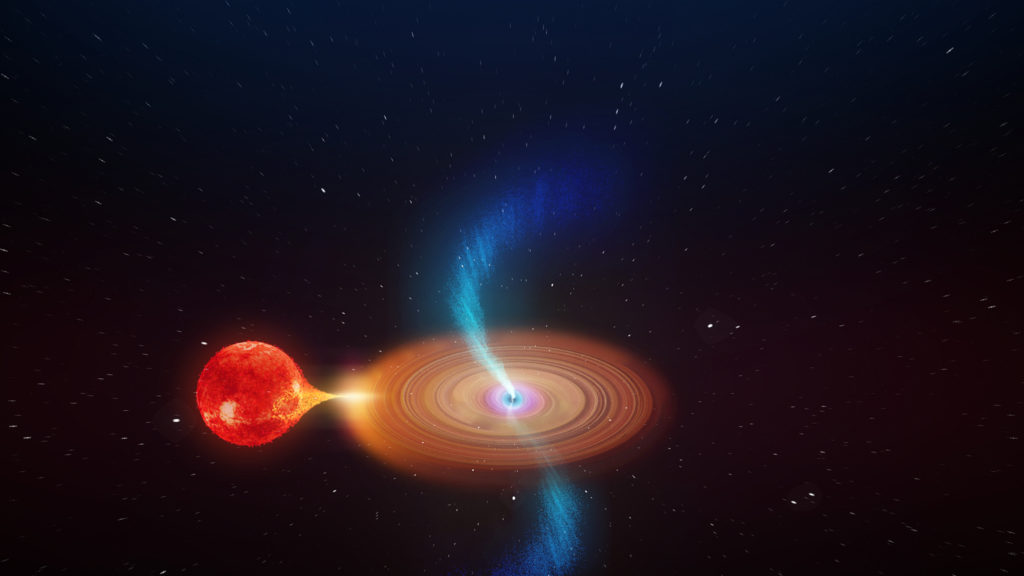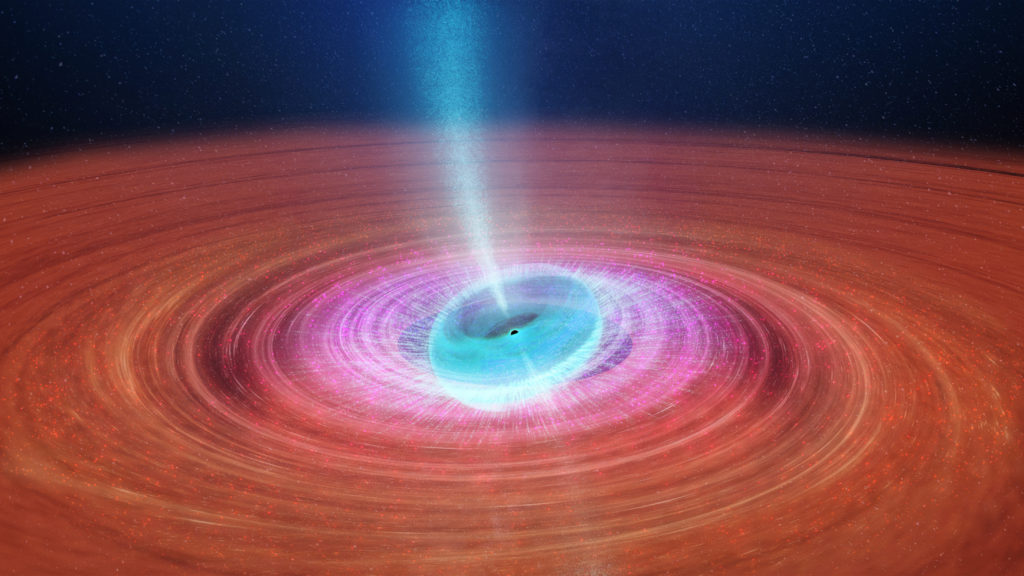This Black Hole's Jets Wobble Like Crazy Because It's Warping Space-Time
This black hole's jets are wobbling at record speed!
Astronomers have spotted wildly wobbling jets of particles spewing out of a black hole, and they think this unusually rapid motion could be happening because the black hole's strong gravity is warping space around it.
The black hole, named V404 Cygni, is located about 8,000 light-years from Earth and is relatively small as far as black holes go — only nine times the mass of Earth's sun. It is part of a binary system in which it and a sun-like star orbit one another. The black hole is constantly siphoning material from its stellar companion, and as that material gets sucked in, it forms an accretion disk around the black hole.
Some of the particles falling into the black hole escape through relativistic jets, long beams of energetic plasma that flow from the black hole's axis of rotation at more than half the speed of light. Astronomers have seen black hole jets before but have never seen jets that wobble as rapidly as those from V404 Cygni, which were observed oscillating over time periods of only a few minutes.
Related: The Strangest Black Holes in the Universe

"We've never seen this effect happening on such short time scales," James Miller-Jones, a researcher with the International Centre for Radio Astronomy Research (ICRAR) who led the new study, said in a statement.
Miller-Jones and colleagues observed V404 Cygni using the Very Long Baseline Array (VLBA), a network of 10 radio telescopes spread out across the globe that are owned and operated by the National Science Foundation (NSF). The black hole has been the subject of observations since 1938, when it released a bright burst of energy. Its most recent outburst, in 2015, spawned a new wave of interest in the black hole, and it was then that Miller-Jones and his team began the observations for this study.
When the researchers first observed the black hole and pieced together images from the VLBA data, the jets "were changing so fast that in a 4-hour image, we saw just a blur," Alex Tetarenko, an East Asian Observatory fellow in Hawaii who contributed to the study, said in the statement.
Get the Space.com Newsletter
Breaking space news, the latest updates on rocket launches, skywatching events and more!
Astronomers typically use long exposures to observe black holes, but this time they had to modify their strategy to get a clear view of V404 Cygni's jets. So, they captured more than 100 images with 70-second exposures and pieced them together into an animation.
"We were gobsmacked by what we saw in this system — it was completely unexpected," Greg Sivakoff, an astronomer at the University of Alberta and a co-author of the study, said in the statement. "Finding this astronomical first has deepened our understanding of how black holes and galaxy formation can work. It tells us a little more about that big question: 'How did we get here?'"
Astronomers think the black hole's swift wobble can be explained by Albert Einstein's general theory of relativity, which stipulates that extremely massive objects bend space and time. "When such a massive object is spinning, its gravitational influence pulls space and time around with it, an effect called frame-dragging," officials with the National Radio Astronomy Observatory (NRAO), an NSF facility that runs the VLBA, said in the statement.
As particles get sucked toward the black hole, the accretion disk gets denser and hotter closer to the center. Near the center of the disk is a dense, doughnut-shaped ring that is "puffed up" by radiation pressure. While the accretion disk is about 6.2 million miles (10 million kilometers) across, the doughnut is only a few thousand kilometers wide. This is where space gets warped by the immense gravitational force.

The frame-dragging effect seems to arise because the black hole's spin axis is misaligned with the plane of the black hole's orbit with its binary companion. That misalignment "causes the frame-dragging effect to warp the inner part of the disk, then pull the warped portion around with it," NRAO officials said. "Since the jets originate from either the inner disk or the black hole, this changes the jet orientation, producing the wobbling observed with the VLBA."
"You can think of it like the wobble of a spinning top as it slows down. Only in this case, the wobble is caused by Einstein's general theory of relativity," Miller-Jones said.
While the researchers may have an explanation for the wildly wobbling jets of V404 Cygni, they have not yet figured out exactly where those jets are coming from. When it comes to black holes' relativistic jets, their origins remain a bit of a mystery — not just for V404 Cygni, but for all black holes. Scientists think the jets originate either in the inner portion of a black hole's accretion disk or in the black hole itself.
Regardless of the jets' origins, however, this new research suggests that the wobbling of the inner accretion disk "could play a role in either directly launching or redirecting the jets," the study's authors wrote in their paper, which was published today (April 29) in the journal Nature.
- Historic First Images of a Black Hole Show Einstein Was Right (Again)
- Visible Light from a Black Hole Spotted by Telescope, a First
- Rare View of Black Hole Caught in 'Bull's-Eye' Eruption (Video)
Email Hanneke Weitering at hweitering@space.com or follow her @hannekescience. Follow us on Twitter @Spacedotcom and on Facebook.
Join our Space Forums to keep talking space on the latest missions, night sky and more! And if you have a news tip, correction or comment, let us know at: community@space.com.

Hanneke Weitering is a multimedia journalist in the Pacific Northwest reporting on the future of aviation at FutureFlight.aero and Aviation International News and was previously the Editor for Spaceflight and Astronomy news here at Space.com. As an editor with over 10 years of experience in science journalism she has previously written for Scholastic Classroom Magazines, MedPage Today and The Joint Institute for Computational Sciences at Oak Ridge National Laboratory. After studying physics at the University of Tennessee in her hometown of Knoxville, she earned her graduate degree in Science, Health and Environmental Reporting (SHERP) from New York University. Hanneke joined the Space.com team in 2016 as a staff writer and producer, covering topics including spaceflight and astronomy. She currently lives in Seattle, home of the Space Needle, with her cat and two snakes. In her spare time, Hanneke enjoys exploring the Rocky Mountains, basking in nature and looking for dark skies to gaze at the cosmos.









